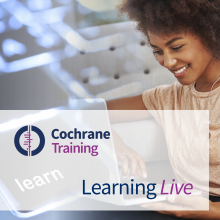 These videos, originally part of the Cochrane Learning Live webinar series, explain why, and how, a group of stroke survivors, carers and physiotherapists worked together to co-develop a model that describes physical rehabilitation after stroke. The session aimed to shape a model of physical rehabilitation that will be used to bring research evidence together, and it asked for people's thoughts and feedback to help make further changes and improvements to this model.
These videos, originally part of the Cochrane Learning Live webinar series, explain why, and how, a group of stroke survivors, carers and physiotherapists worked together to co-develop a model that describes physical rehabilitation after stroke. The session aimed to shape a model of physical rehabilitation that will be used to bring research evidence together, and it asked for people's thoughts and feedback to help make further changes and improvements to this model.
The webinar was delivered in March 2022 and below you will find the videos from the webinar, together with accompanying slides to download [PDF]. Please send your feedback on the review to Dr Alex Todhunter-Brown, lead author, by emailing alex.todhunterbrown@gcu.ac.uk
Part 1: Introduction & stakeholder engagement
Part 2: A new model for stroke rehabilitation
Part 3: Questions and answers
Why do we need a model of physical rehabilitation?
Cochrane systematic reviews bring together evidence from clinical trials to investigate the effectiveness of different interventions for people with healthcare problems. Cochrane Stroke's review investigates evidence relating to physical rehabilitation to improve function and walking in people who have had a stroke. “Physical rehabilitation” is a complex intervention which can include many different things, and be delivered in many different ways. There are therefore lots of challenges to this Cochrane review. Cochrane Stroke's team has worked with a group of stakeholders (including stroke survivors, carers and physiotherapists) to co-develop a model and description of physical rehabilitation for stroke. They plan to use this model within the Cochrane review.
This webinar included a series of presentations covering:
- Why it was important to have a detailed description of “physical rehabilitation” for the review.
- The way in which different people were involved in developing a description of physical rehabilitation
- The ‘model’ of physical rehabilitation that has been co-developed by stroke survivors, carers and physiotherapists
- Reflection from people involved in the process and outcomes
The session was primarily aimed at people with an interest in, or experience of, physical rehabilitation after stroke. This includes stroke survivors, carers, and health professionals from anywhere in the world. It was also of interest to people who want to learn more about how people (including patients, carers and health professionals) can be involved in Cochrane reviews. Cochrane consumers, authors or editors may also be interested. The presented example may give you ideas about how to involve people in other reviews.
Presenter Bios
Alex Todhunter-Brown (formerly Pollock) is a Senior Research Fellow at the Nursing, Midwifery and Allied Health Professions (NMAHP) Research Unit, Glasgow Caledonian University. She has particular expertise relating to systematic reviews of complex interventions, leading methodological work, completing and supporting systematic reviews across the unit. She is joint Co-ordinating editor with the Cochrane Stroke Group and an author on 11 Cochrane systematic reviews, 2 Cochrane overviews and multiple other peer-reviewed evidence syntheses. She has published papers relating to methods for complex systematic reviews and overviews. Alex has an active interest in active and meaningful public involvement in research, with a particular focus on involvement in systematic reviews. She was the invited lead author of a chapter on involving stakeholders in systematic reviews for the 2021 Guideline International Network (GIN) Toolkit (available here). She led the ACTIVE project, funded by Cochrane Training, aimed at supporting review authors have meaningful involvement of patients and the public in systematic reviews. This project involved reviewing evidence relating to stakeholder involvement in systematic reviews and developing the content of Cochrane’s Involving People resource.
Richard Morley is Cochrane’s Consumer Engagement Officer. He supports the engagement and involvement of healthcare consumers (patients, carers, and the public) in Cochrane’s research and governance, including working with a growing network of nearly 2,000 volunteers across the world. He works with Cochrane authors and Groups and a range of partnerships that support this engagement, including the new International Network for Patient and Public Involvement in Research, of which he was a founder member. Richard has extensive experience of public engagement and partnership working in the voluntary, public and higher education sectors. He has worked as an adviser for the James Lind Alliance, supporting research priority setting at the University of York’s Department of Health Science on patient involvement where he is a Visiting Fellow.
Gillian Baer is a Senior Lecturer in Physiotherapy in the School of Health Sciences, Queen Margaret University, Edinburgh. Her main areas of research are the investigation and evaluation of rehabilitation in people living with long-term neurological conditions, in particular rehabilitation for people living with stroke. Her research includes conducting randomised controlled trials evaluating the effectiveness of therapeutic interventions, exploring strategies to facilitate physical activity, exploring the application of skill acquisition theories to learn and relearn motor skills and undertaking qualitative studies exploring the experiences of staff delivering rehabilitation and how people living with long-term neurological conditions experience rehabilitation. Gill has been involved in developing all 3 versions of the Cochrane Systematic Review investigating Physical rehabilitation approaches for the recovery of function and mobility following stroke.
Julie Duncan Millar is a postdoctoral stroke researcher who helps to coordinate the patient and public involvement group for this systematic review. Prior to undertaking her PhD, Julie worked as a specialist neurological physiotherapist. Julie is interested in ensuring evidence is relevant and useful for clinical practice, with the aim of improving the lives of stroke survivors, their family and friends.
